In my previous two articles – I’ve talked about how one might approach enjoying gun range time in the States and outlined my first range experiences in that wonderful country.
In short, armed with a credit card, passport, friendly disposition and a reasonably good idea how to make a hand gun safe you’ll be able to buy range time for a gun of your choice. Some US states (such as Florida) won’t allow solo shooters (bring SWMBO) and impose a mandatory safety lesson requirement during your first visit but other than cost and time, that is no great overhead.
All puffins would no doubt agree… very sensible.
Range time in other European cities (for example the Czech Republic, Poland and Switzerland) are all viable options for UK citizens given none of these countries signup to the idea that gun confiscation equates to low gun crime. As those countries often point out, the UK has the harshest gun laws in the world and yet still has a very big gun crime problem. By contrast the Czech Republic firearms model rightly uses licensing, assessment exams, health and criminal background checks but importantly permits concealed carrying of hand guns for personal self defence. They have a lower rate of homicide (18% lower), rape (83% lower), robbery (67% lower), and violent assault (78% lower) compared to the UK and yet have well over 700,000 registered firearms (2013) in circulation.
After you’re checked in at the range you’ll select a gun, a couple of boxes of rounds and paper targets. Armed with ear and eye protection the staff will tell you which firing lane to use. On newer ranges you may have to pass through a containment chamber to get to the range with two electronic doors (controlled so that only one can be open at a time). For those of us using rental guns, staff generally bring your chosen gun to the lane (ie: you won’t carry it in/out) and a range safety officer will often need to be present while you shoot.
You approach your designated lane and the fun can start…
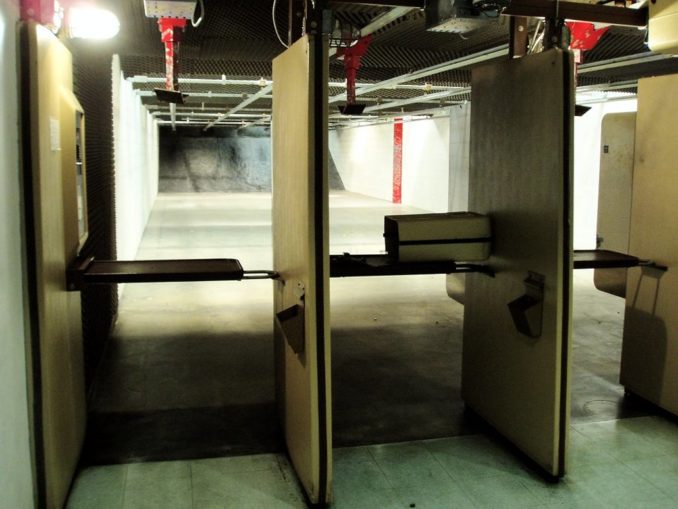
In the image above you can see 3 lanes and where each has a small drop-down table where a gun can be left down (always with the muzzle pointing down range). You can change magazines or use multiple guns here, assuming you have more than one. On the left side of the enclosure, eagle eyed puffins will spot what looks like a controller at eye height used to set the motorised target carrier distance. Generally for personal self defence the length of an upstairs hallway (roughly 5 to 10 yards) is recommended.
When standing on the firing line, if you were to turn 180 degrees round, you’d find benches (sometimes referred to as the working area) where you can keep your stuff, including boxes of rounds, any tools, paper targets, unloaded guns (if you’re an owner) and magazine loading tools such as the handy Maglula UpLULA tool that Mrs VC and I used to speed up the process of loading rounds into magazines – see below.
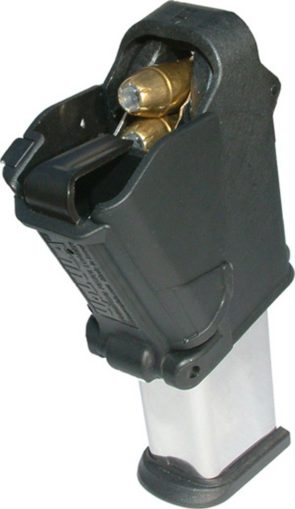
The working area is also nice for chatting with other range users and taking a break. In the case of rentals, the ranges I visited required me to leave the gun (or guns) on the firing line table but other gun owners visiting the range could freely move a gun from the firing line to the working area so long as it was made safe.
So, range rules are pretty straightforward. Assuming the range safety officer hasn’t called a halt to firing, you can step up to the firing line and while pointing the muzzle down range at all times you can load and fire your gun. Whenever you leave the firing line, the gun should be unloaded and made safe. Even if you were to leave the firing line for just a second, perhaps to step back to grab another paper target sheet, make the gun safe before you leave. So in short, the working area is reserved for unloaded and safe weapons. The firing line is the only place you can have a loaded gun and it must point down range at all times.
When shooting, keep your ears peeled for a firing halt. On some ranges the officer will shout to call a halt, other ranges might use a loud bell but either way, a halt doesn’t happen often and during my visits it only happened once (after I’d dropped a live round which rolled onto the range and I asked for a halt). But, a halt could be called at any time.
As a matter of personal discipline it helps to keep your firing line table tidy, because if a halt is called to firing, you’ll need to make your gun safe and place it on this table for inspection with the muzzle pointing down range, magazine removed, slide locked back and ejection port up. At that point you step back so that the range safety officer can look into the ejection port to confirm the gun is safe. As I’ve mentioned before, none of this is rushed or panicky. It is controlled, smooth and orderly and most range safety officers will be only too happy to watch you carefully/slowly carry this task out.
I’ve been lucky and found that safety officers are a friendly bunch, they tend to appreciate attention to detail and are good at what they do. That said, not all ranges are as good as they could be.
In the above example – a jammed loaded weapon has been removed from the firing line and brought to the rear working area which is error #1. The individual attempting to clear the jam then manages to shoot two people.
Look at the video. What do you see?
There are at least four failures and one potential oddity I can spot.
- A loaded weapon (regardless of the jam) should never be removed from the firing line until it has been made safe. That means you should clear the jam on the firing line while keeping the muzzle pointing down range at all times. If you get stuck, keep your finger out of the trigger guard and the muzzle pointing down range and simply ask for help.
- The fact that this bloke left the firing line with a loaded weapon is bad enough, but he is also so completely preoccupied with the problem that he exhibits no awareness of where the muzzle is pointing. One might say he had zero muzzle awareness (see below).
- As he attempts to clear the gun jam, he had his finger inside the guard and on the trigger.
- An oddity for me are the three other chaps on the firing line who appear distracted and confused. Precisely what condition were their guns in at that time?
- Range safety officer(s) should have been present and should have intervened.
When I was lucky enough to shoot on the air gun range in Bisley, folks referred to muzzle awareness, which is having a sense of where the muzzle is pointing at all times, no matter what you’re doing. Range rules for Bisley required that when moving behind the firing line with a rifle, it must be unloaded and muzzle down (remember these are low power rifles – quite unlike shotguns). If for example you were removing an unloaded rifle from a bag before reaching the firing line, you’d never under any circumstances sweep anyone with the muzzle so I used to pull my rifle out vertically, with the muzzle pointing at the concrete floor and my hand gripping the stock. Before raising the rifle to the bench (still pointing down), I’d carefully check the condition of the bolt to make sure it wasn’t cocked and the breech was clear.
Even if you are distracted, maintain your muzzle awareness. For example if someone peers over your shoulder on the firing line to ask you about that wonderful gun you’re shooting, always keep that muzzle pointing down range and if you did want to chat for longer, make the gun safe before doing so. An admirer will appreciate it every bit as much as the safety officer will.
Cast your mind back to the lessons of the video. If a gun fires unexpectedly – referred to as a negligent discharge (ND), it only happens when proper safe handling techniques are ignored. Triggers don’t pull themselves and it will never be a mistake nor will it be an accident.
The bottom line is that there is no excuse for an ND.
Gun Jams… what to do
During range time in Virginia, I hired a Glock 21 chambered in 45ACP.
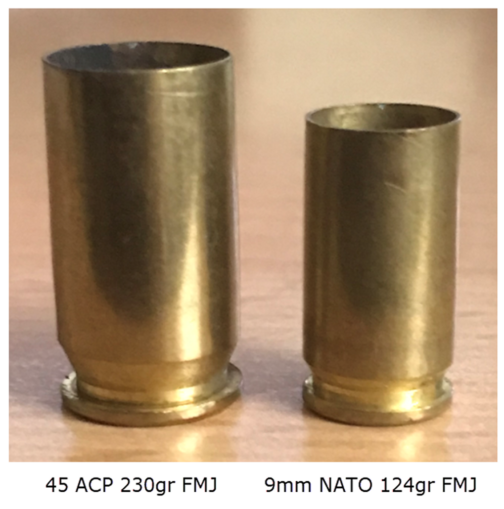
The 45 ACP is a slow lumbering round, some refer to it as a big ol’chunk of lead heading down range. The casing is surprisingly big, in fact it’s so big you can pop a 9mm casing inside and watch it rattle around. 45’s are often thought of as one-stop shots, due to their muzzle energy and size. 45ACP rounds weigh around 230 grains and fly at 850 feet per second – so the muzzle energy is a substantial 369 ft/lb. By contrast 9mm Parabellum rounds are lighter (approx 124 grains) and also travel faster (approx 1050 FPS) but it is their reduced mass that significantly lowers the muzzle energy to a humble 304 ft/lb.

Multiple people I’ve spoken to with military backgrounds have told me that the 9mm Parabellum round was adopted as a standard for NATO because it was more likely to result in a resource-hungry-casualty on the battlefield. Blood thirsty perhaps, but effective in war.
Out of the two guns I’ve used chambered in 45ACP, one was a beautiful 1911A1 back in Florida and the other was this full sized Glock 21.
A Standard 1911A1 has a 7 round magazine while a full sized Glock 21 holds 13 rounds but as it turned out, the magazine in my rental had a bit of a problem. Curiously both these guns suffered from a misfeed problem.
The Glock would cycle fine for the first 3 or 4 rounds after which you’d pull the trigger and the round would fire but the gun felt odd and the slide wouldn’t quite return to its proper battery position ready for the next shot.
Yep… a dreaded jam.
Finger out of the trigger guard, muzzle pointing down range and after locking the slide back I could see that the spent casing had been successfully ejected but the new round had latched up before feeding into the throat of the barrel and was sitting at an odd angle crossways on the feed ramp suggesting that either the ramp had a snag problem (very unlikely with a well used rental) or the spring tension in the magazine might be a little weak.
Remaining on the firing line I removed the magazine at which point the misfed bullet dropped out of the magazine well onto the firing line table. As the gun was now safe and clear I left it down and walked back to the working area bench to look more closely at the cleared magazine where the spring did feel a little weedy. The safety officer agreed. Popping out of the range, the store staff gave me a new magazine (and another box of rounds), which cured my problem… in two different ways – ha.
The staff even gave me an extra 30mins of range time for my trouble.
Faced with the same problem during close quarter combat with a bad guy in your sights and a misfeeding gun, soldiers are trained to use what is called a tap, rack, bang drill (our friendly Navy SEAL Chuck called it a slap, rack, bang drill… you’ll meet Chuck later on) designed to eliminate the problem without investigating the cause. Tap means to apply pressure on the base of the magazine ensuring it is properly and fully locked into the gun. Rack means you rack the slide to eject whatever is in the chamber and load a fresh round. Bang… well bang, simply means you pull the trigger hopefully on a live round. Chuck could carry out a tap rack drill in around a third of a second. Lightening fast… all muscle memory from training.
Interestingly, this type of drill may not have worked with our problem, but on the other hand I’d like to imagine that an experienced firearm handler worth his salt wouldn’t be using a worn out magazine in the first place.
Rare range problems?
Experienced firearms folks will be aware of two other unusual conditions, sometimes (but not always) linked to reloaded rounds.
Reloading is where a spent casing is used again. The process is involved, calling for skill and experience. Whenever a round is fired, the expansion of gas causes the brass casing to swell, so used casings have to be resized. A new percussion cap has to be fitted, the casing filled with the right amount and type of powder and a bullet press fitted into the end. Skilled folks do this all the time and very successfully… but as you’ll appreciate, the process is dependent on a host of factors, skill being just one.
Most gun manufacturers specifically exclude reloaded rounds under gun warranties so my guess is that the quality is likely to vary compared to manufactured rounds.
Squib loads
A squib is where a bullet fires but where the propellant doesn’t have sufficient energy to cause the bullet to exit the barrel and so the barrel ends up blocked. Often this type of failure results from an inadequate amount of powder in the casing. Usually a squib will be blindingly obvious at the point of firing because the gun sound will be muted and weak and the slide may not properly cycle. The recoil will also be much reduced hence you’ll hear expressions such as “pop and no kick” when referring to squibs.
The fun begins if a semi automatic gun does somehow manage to cycle after a squib and you pull the trigger on what is now a blocked barrel (same er… fun applies with a revolver).
The video below has some good examples of this rare occurrence.
Once you’ve got the gist of the problem have a look at the excellent range safety officer at time 0:48 in the above video, instantly recognizing what has happened and taking charge. The student learned something valuable, which I doubt he’ll forget. The student at 1:36 also exhibits good discipline. He knows something is wrong and so stops to think but while doing so maintains full muzzle awareness. Although he is slow removing his finger from the guard, you can see he’s off trigger and just 4 seconds go by before he carefully removes his finger from the guard saying “I don’t know (what happened) but I no longer want to shoot it”.
Not much work required for that one… top bloke.
Don’t get me wrong, squibs are extremely rare (I’ve never actually heard of one happening with a hand gun and I’ve certainly never seen one) but if for example you borrowed another persons handgun on a range (as I did multiple times), there is a possibility that you will use their magazine and their rounds – which means you might end up using reloaded rounds (assuming range policy allows their use). If at the point of firing the gun sounds odd, weak or muted, I’d definitely make the gun safe and then investigate further before I took any more shots. A good tip is to carry a barrel snake cleaning cord (even a shoe lace would do) which you can pass through the ejection port with the slide locked back and then down through the barrel to make absolutely sure it is clear.
Hangfire
Hangfire is a term describing another mercifully rare event where propellant in the cartridge is slow to ignite, sometimes by as much as 1 to 5 seconds. On really old black powder weapons, I’ve heard of instances where that delay can be as much as 30 seconds. You pull the trigger and there is a distinct pause before firing occurs.
Ok so someone fires a gun and hears a mechanical click instead of a bang.
Would they ever be sufficiently daft to up-end the rifle and carefully peer down the barrels loud end to see if they might find that elusive missing bullet?
No one would be that daft, right?
Well, in the video below, you’ll note at time 1:00 a bloke does exactly that, followed by a fairly good impression of a jumping frog (prefab sprout anyone?). His hat didn’t do so well, but thankfully he faired somewhat better (I think), although I suspect he might forever be one step away from a Darwin award.
A range is where you learn so if anything unexpected occurs, maintain your muzzle awareness, stop, think and if necessary ask for help whenever anything feels wrong.
Flinch
A meeeeja reporter once asked an SAS soldier “what do you feel whenever you shoot the enemy?”
The soldier shrugged and replied… recoil.
Ok so you’re on a range:
- You fire your pistol and there is a really loud bang.
- Your arm feels a significant force lifting it upwards at the moment of firing.
- All the time, your eye is locked on the target and while your brain is coping with all the noise and the recoil it is also trying to make sure you hit the target.
But the question is, what exactly is your brain doing?
The very first time I fired a 9mm hand gun on a range, I was able to shoot a group inside a 4 inch radius at around 5 yards. I grouped 5 inches at 7 yards and as this was my first time it felt like a reasonable start. I visited the range multiple times after that, but noticed something odd… the more times I visited, the worse my grouping seemed to become. A penultimate moment for me was visiting a range in Virginia with my sister, brother in law, my wife (Mrs VC) and a retired Navy SEAL on a memorably enjoyable firearms training day, all ready to show off my super duper hand gun shooting ability, only to shoot an appalling 6 inch group at just 5 yards. At 7 yards some of my shots didn’t even hit paper.
With no range experience at all, both my wife and sister shot vastly better tighter patterns.
They were simply miles better than I was.
Chuck was the retired Navy SEAL we had with us for that training day and he instantly figured out what my problem was. He took me to one side at the end of the session and asked if I was ready to explore the problem… to which I enthusiastically said yes. We were firing a Glock 17.
He took the magazine back to the working area, returning with a full magazine and asked me to shoot slow controlled shots at the target sheet.
Magazine in, slide cycled, I began shooting… but again my shots were all over the place and I found myself completely at a loss to understand what the hell was going on until I reached shot 6 when I heard nothing more than a click but the really strange thing was what I saw my hands do right in front of my face.
To my complete surprise, both hands dipped sharply, lowering the muzzle towards the ground at the point of the click. It was a real “oh my” moment for me because my own downward hand movement was huge but I had absolutely no clue I was doing it. It was completely involuntary and a big surprise.
This phenomena is known as Flinch and is a common problem with folks who visit a range without any formal training. These folks will often do well on their first visit but then become less accurate the more visits they enjoy.
Flinch occurs because the brain is focused on the visual target while trying to deal with the shock and noise as well as the natural tendency for a muzzle to lift when fired. Without suitable controls in place, the brain will train itself to overcompensate for muzzle lift by generating an opposite force downwards and due to all the noise and recoil at the precise time of firing it can be extremely hard to spot.
In my case, Chuck had used a technique called Ball and Dummy to reveal my problem.
Ball and Dummy is where a magazine is filled with live rounds except for one dummy plastic round placed randomly in the stack. The shooter has no idea where the dummy round will be… and so if their brain is adding any significant flinch muscle movement, a B&D magazine will find it as soon as that dummy round is reached. SEAL training often randomly inserts dummy rounds into magazines so that soldiers can practice tap rack drills but also so they can assess any tendency to flinch. Dry firing drills can then be used to compensate if flinch is creeping in (see further down).
Chuck taught me two techniques to manage flinch. If you’re using something like a Glock (where the top of the slide is flat) pick up a spent casing from the floor before you take a shot and rest it on the nose end of the gun. Simply pull the trigger on your next shot but without dislodging the spent casing (it’ll fly off when the slide cycles – but stillness at the precise moment the trigger is pulled is the key here).
Another effective long term training technique is known as dry fire drill. Doing this at the range or before getting to the range will allow you to retrain your brain so that it doesn’t make this “flinch” mistake. You need to carry out dry fire drills regularly for this to work.
Just to reiterate, flinch takes place when the brain trains itself to anticipate recoil but over compensates. The ideal is zero movement at the point of firing but the brain thinks it needs to add more muzzle movement downwards in order to maintain a line on the target. Dry fire practice is a fiendishly simple training tool that counters this error by retraining the brain not to apply any compensation whatsoever at the precise moment the trigger is pulled.
Turn up at the range get on to the firing line, gun in hand but made safe. With the magazine removed, rack the slide to cock the firing pin (or hammer), aim and pull the trigger (click… no bang) but make sure the gun remains squarely on target with no muzzle lift or drop.
Now repeat this 50 times right there on the firing line.
Sounds crazy doesn’t it!
All you’ll be doing for the next couple of minutes with this empty gun will be to rack the slide, aim and pull the trigger while keeping the muzzle steady… click. Then repeat: rack the slide, aim, pull the trigger… click. Rack the slide, aim, pull the trigger… click – all the time making sure that the gun nose doesn’t move when the trigger is pulled.
Folks at the range who were looking on in the working area thought I was proper daft while I was doing this… but I smiled when I noticed that both safety officers knew exactly what I was doing. After 50 dry firing cycles, I inserted a loaded magazine, racked the slide, took aim at 7 yards and got bullet on bullet groups on my target, shooting quickly and with purpose. I fired two groups at the target, one at the heart and the other at the head.
I doubt the two resulting groups were wider than ¾ inch each.
The same folks in the working area then became quite interested in what I was doing and why.
Coupling dry fire drills, tap rack drills and more range time, I believe I could easily achieve reliable 3” groups at 10 yards with a hand gun which for personal self defence would be acceptable. The next step for me would be simulated combat drills to build all important muscle memory under stress conditions… which I’d absolutely love to tackle.
If you ever did find yourself in a self defence home invasion position, you’ll almost certainly appreciate that with adrenaline in full flow, any fine motor skills you may have had will simply vanish. So the general rule of thumb is that if you can obtain 3” groups with a hand gun at 10 yards reliably when calm, the chances are you’ll get adequate shots to do the job at much closer range under duress.
Does this all sound a little academic here in the UK, given our only legal option is to forever be a victim?
Well maybe, but one thing it does do is pour scorn on any claim that the public are incapable of acquiring the skills necessary to shoot for self defence while possessing a detailed understanding of safe handling and backstops. I’ve lost count of the number of folks who wrongly assert this nonsense – and I have to say most are generally UK citizens. If you can learn to drive, you can learn to shoot and you can learn to shoot well !
I own a cheapy BB air pistol (a Remington 1911) that I bought second hand for a tenner some years ago. It doesn’t work overly well (the accuracy is ridiculously bad), but the slide cycles and the hammer locks back. I use that toy gun for quiet dry fire training every day for around 5 minutes, as I found that even my air rifle shooting improved. Also, I know that any time I do get a chance to visit a gun range, I am trained and ready to avoid flinch.
Dry firing is a very simple technique, but believe me when I say it is astonishingly effective and well worth knowing about before you visit a range. It is a technique that I have shared far and wide on bookface before I left a couple of years back and even very experienced shooters in the States came back to thank me afterwards.
My thanks to Chuck and my very best regards to any SEAL readers out there.
SAS and SEALS – the warrior elite!
Next Steps
The next instalment will be a critique of my favourite semi auto hand gun… the Sig P226 and also perhaps the little snubby CZ75 semi auto. Although I didn’t get much time to use that little pistol (loaned to me by the safety officer) I was struck by just how good it was.
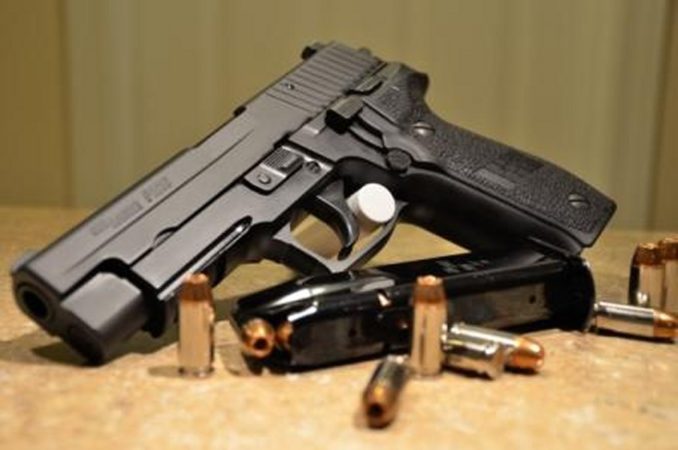
BankingBum at en.wikipedia, CC BY-SA 3.0, via Wikimedia Commons
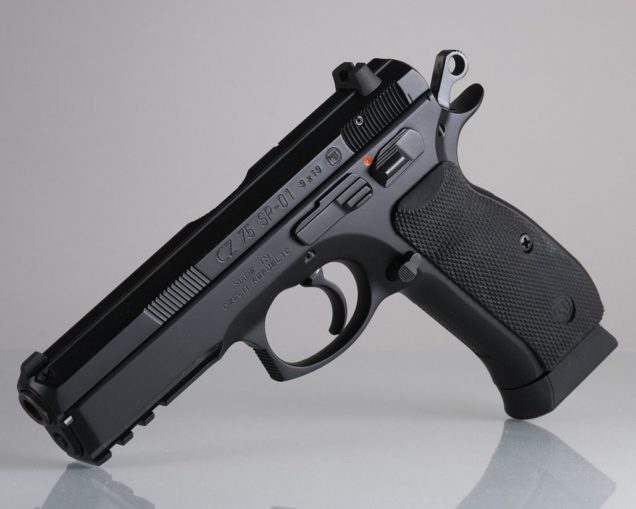
Twiek, CC BY-SA 3.0, via Wikimedia Commons
The P226 has a nice characteristic that you can carry it safely with a round chambered but with the hammer decocked. In that state, the gun is drop safe but also double action on the first round. The CJ75 is a more conventional semi automatic but a perfect concealed carry weapon (CCW) because it is quite short and snubby.
Both are excellent personal self defence machines.
© text & images Verax Cincinnatus 2021
The Goodnight Vienna Audio file
Audio Player



